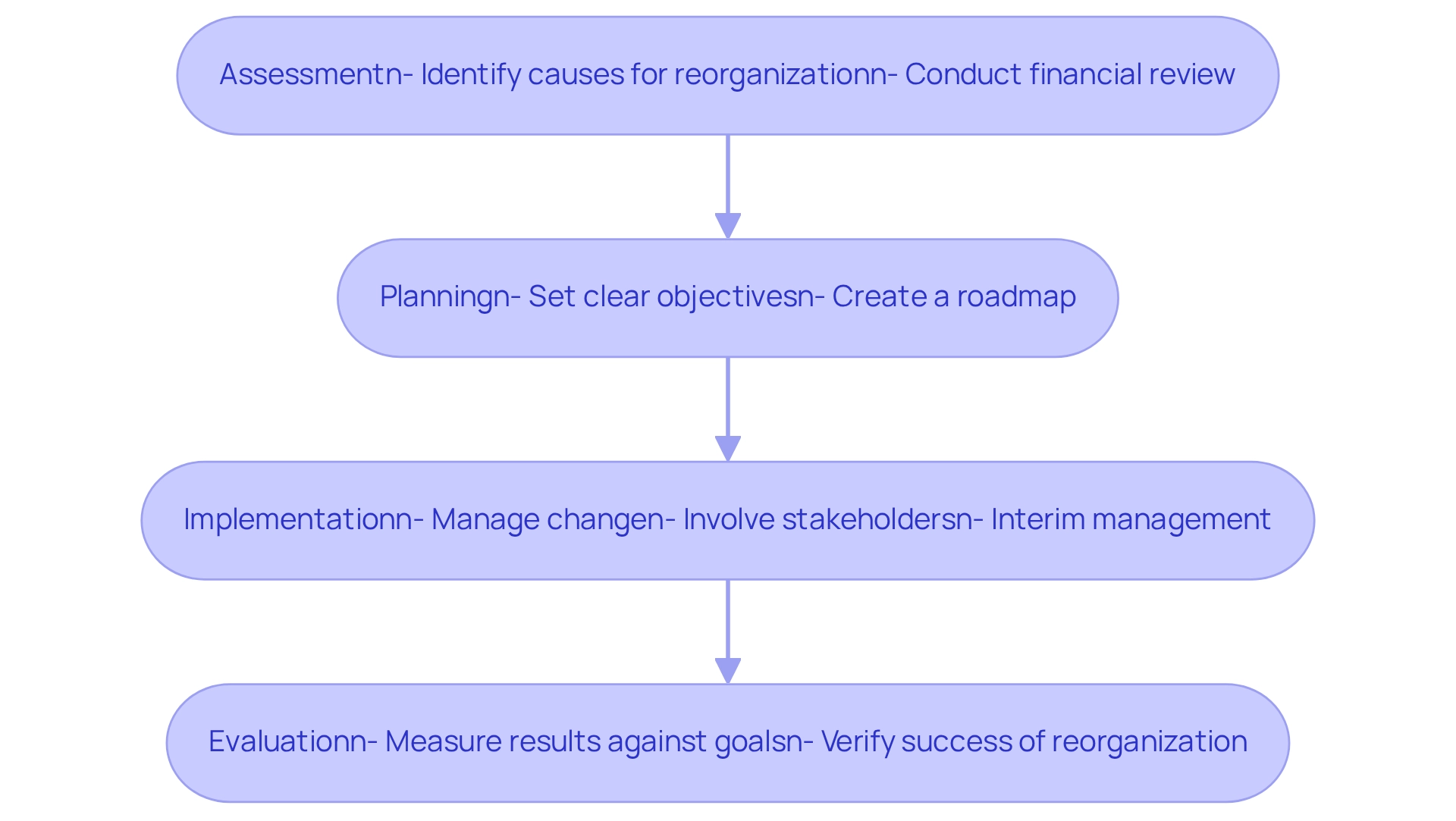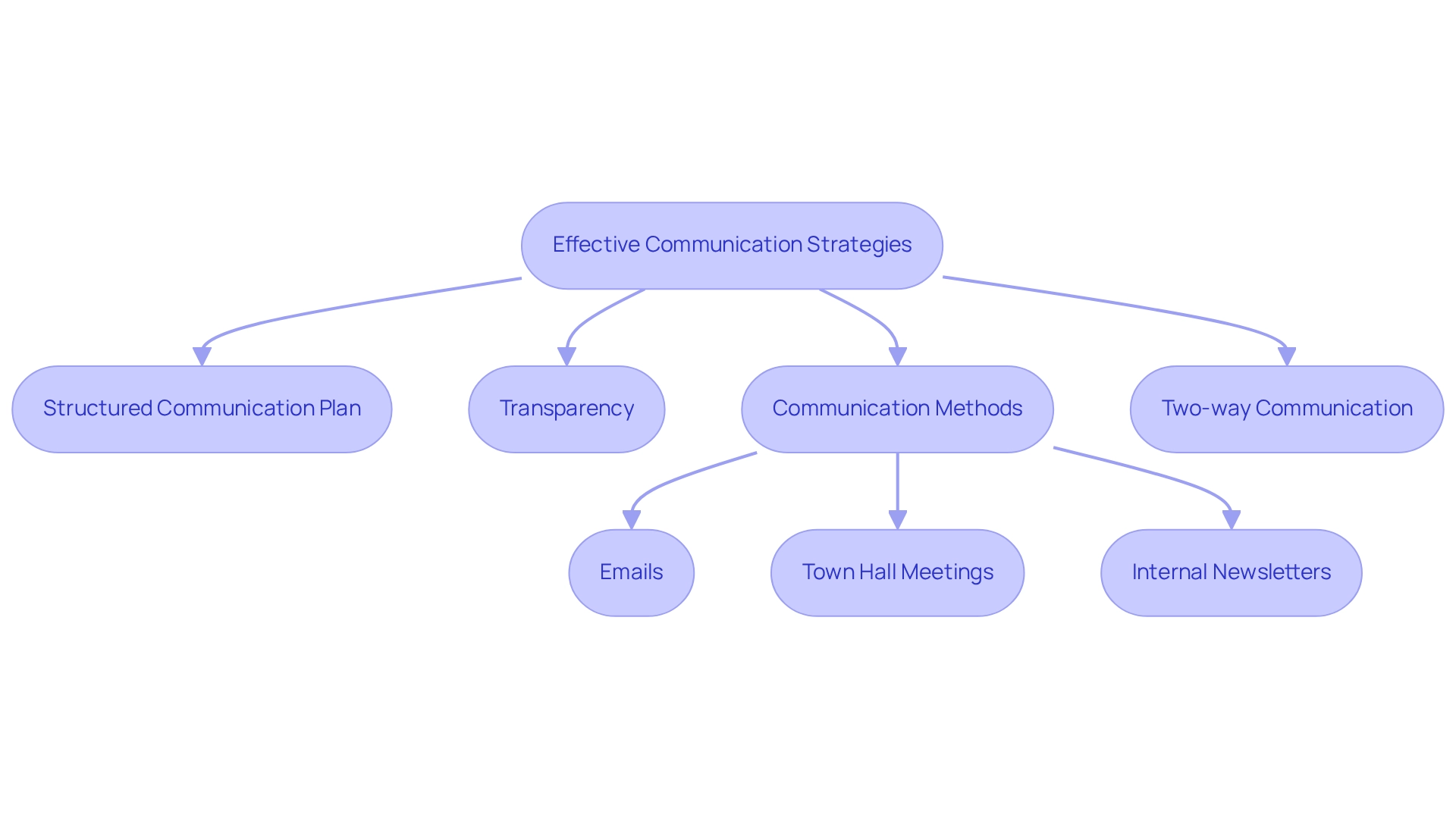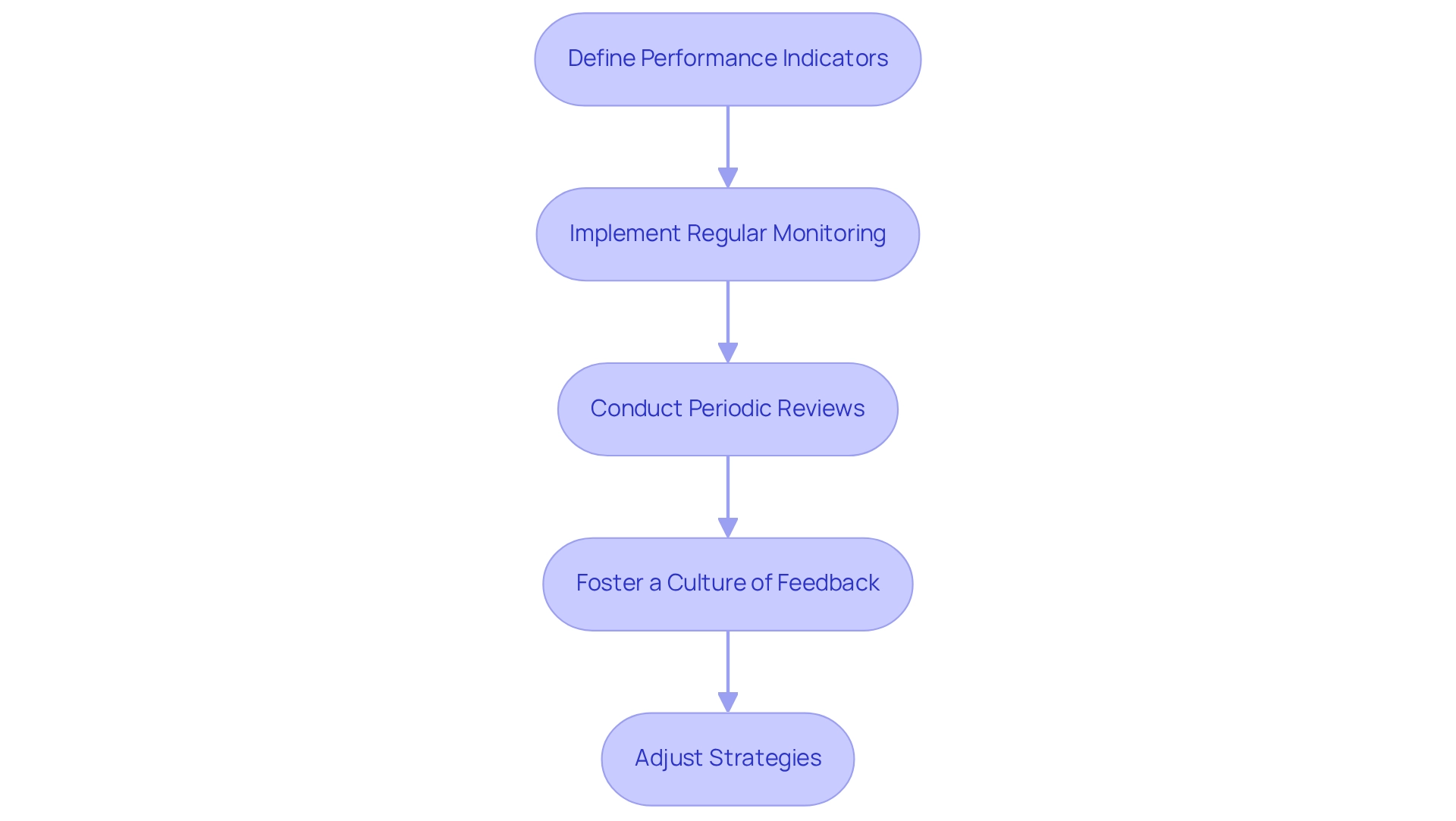Overview
This article delineates five pivotal strategies for effective operational execution amid organizational restructuring:
- Assessment
- Planning
- Communication
- Leadership alignment
- Continuous evaluation
These strategies are indispensable as they foster a structured approach to managing change, ensuring stakeholder engagement, and significantly enhancing the likelihood of successful outcomes. Given the myriad challenges organizations encounter in adapting to change, embracing these strategies is not merely advisable but essential. By implementing these frameworks, organizations can navigate the complexities of restructuring with confidence and clarity.
Introduction
In the dynamic realm of business, organizations frequently navigate the intricate waters of restructuring. This multifaceted process transcends mere reactions to financial distress or operational inefficiencies; it presents a pivotal opportunity for transformative growth and renewed focus.
From the initial evaluation of underlying issues to the meticulous planning and execution phases, each step demands strategic foresight and effective communication. As companies confront the challenges of change management, aligning leadership with team dynamics becomes essential for cultivating a culture of collaboration and engagement.
By adopting robust communication strategies and persistently monitoring outcomes, businesses can not only endure the restructuring process but also flourish in its wake. This article explores the crucial stages of restructuring, providing insights and best practices that can convert potential upheaval into a springboard for success.
Understand the Restructuring Process
The reorganization process encompasses several critical stages: assessment, planning, implementation, and evaluation. Each stage demands meticulous attention and strategic foresight.
In the assessment phase, organizations must identify the underlying causes for reorganization, such as financial distress or operational inefficiencies. A thorough financial review during this phase can help identify opportunities to preserve cash and reduce liabilities, enabling a tailored approach to the reorganization plan, including .
During the planning stage, it is crucial to set clear objectives and create a thorough roadmap to attain these goals, utilizing customized turnaround and consulting services that emphasize operational execution for restructuring. The execution of the plan involves effectively managing change while ensuring that all stakeholders are involved and informed. This is where interim management can play a crucial role, providing hands-on executive leadership for crisis resolution and transformational change through structured processes like the Rapid-30 approach.
Ultimately, the evaluation phase measures the results against the initial aims, verifying whether the reorganization has achieved its intended goals.
Recent statistics indicate that only 43% of employees believe their workplace effectively handles change, a significant drop from almost 60% in 2019. This highlights the urgent need for robust strategies in operational execution for restructuring. Successful companies often exemplify best practices in navigating these stages. For instance, organizations that maintain a strategic focus during transformations are significantly more likely to succeed; research indicates that those centered on technology alone are twice as likely to fail. By combining employee involvement, open communication, and the right tools, organizations can transform change into an opportunity for growth. Notably, addressing workplace burnout—reported by two-thirds of workers—can enhance engagement and effectiveness during this process.
Real-world examples illustrate the effectiveness of this structured approach. Organizations that have effectively managed reorganization often highlight the significance of comprehensive evaluation and strategic planning in their operational execution for restructuring, resulting in enhanced operational efficiency and financial stability. Comprehending bankruptcy filing statistics can also guide the evaluation phase, especially for enterprises encountering financial hardship.
As the commerce environment continues to evolve, with 79.7% of entities needing to adjust their strategies every two to five years, understanding and executing these crucial phases of the transformation process is essential for lasting success.

Conduct Thorough Financial Assessments
For successful organizational changes, conducting thorough financial evaluations is essential for operational execution for restructuring. This process involves a comprehensive analysis of key financial statements, cash flow projections, and operational costs. Utilizing tools such as ratio analysis and benchmarking against industry standards enables entities to pinpoint areas of concern effectively.
Companies experiencing liquidity challenges can benefit significantly from detailed cash flow analyses that identify cash drains and inefficiencies, and the operational execution for restructuring liabilities and exploring opportunities for debt restructuring can markedly enhance financial stability. In 2025, the significance of these evaluations is emphasized by the fact that 37% of small enterprise owners have contemplated ceasing operations due to late payment issues, highlighting the necessity for operational execution for restructuring in .
Implementing thorough financial assessments not only clarifies the current financial health of an organization but also informs strategic decision-making for future growth. This is where expert guidance, such as that provided in a Business Valuation Report, becomes invaluable. By leveraging AI/ML strategies, organizations can streamline decision-making processes and utilize real-time analytics to monitor performance continuously.
Case studies illustrate this point effectively; for instance, an operational efficiency analysis assesses how effectively an organization utilizes its resources to generate revenue, comparing costs of stock, labor, and overhead to revenue generation activities. By assessing operational execution for restructuring, companies can pinpoint areas for enhancement, lower expenses, and boost overall productivity, highlighting the transformative potential of these practices.
As entities pursue operational execution for restructuring, the incorporation of financial analysis tools becomes crucial in fostering sustainable change and attaining long-term success. Moreover, with 54% of U.S. small businesses having sought a business loan or line of credit in 2018, the necessity for comprehensive financial evaluations becomes even more vital in ensuring financial stability during organizational changes.
Align Leadership and Team Dynamics
Aligning leadership with team dynamics is essential for successful reorganization, necessitating open communication and a unified vision. Leaders must clearly articulate organizational goals and actively engage their teams throughout the process. This can be facilitated through regular meetings, workshops, and feedback sessions that invite contributions from all organizational levels. Understanding team dynamics—including roles, responsibilities, and interpersonal relationships—enables leaders to identify potential resistance and address it proactively. For instance, a company that effectively restructured its operations discovered that involving team members in decision-making fostered a sense of ownership and commitment to the new direction.
To support this, our approach emphasizes a shortened decision-making cycle, allowing teams to take decisive action swiftly, which is crucial during a turnaround. Additionally, we utilize real-time business analytics through our client dashboard to continuously monitor performance and diagnose business health, ensuring that leaders have the insights needed to guide their teams effectively. Prioritizing alignment and collaboration not only enhances morale but also boosts productivity during the restructuring process. Significantly, as of 2023, only 43% of employees believe their company excels at managing change, a major decline from nearly 60% in 2019, underscoring the increasing difficulties in change management. Moreover, entities that adopt are better equipped to handle the intricacies of workforce dynamics and technological progress, particularly with forecasts of 97 million new positions arising by 2025. This urgency is underscored by the alarming statistic that 70% of change initiatives fail. By concentrating on leadership alignment and team dynamics, entities can greatly enhance their likelihood of successful reorganization. Additionally, when team members feel safe to be vulnerable, it enhances team performance and morale, further emphasizing the need for effective communication strategies. As Gartner highlights, 54% of the workforce comprehends the change through open source dialogue, emphasizing the vital role of communication in successful transformation efforts.
Implement Effective Communication Strategies
Implementing effective communication strategies necessitates that clearly delineates key messages, channels, and timelines. Prioritizing transparency is essential; organizations must openly share details about the operational execution for restructuring, including its rationale and anticipated outcomes.
Utilizing various communication methods—such as emails, town hall meetings, and internal newsletters—ensures that all staff members receive consistent messages. Furthermore, encouraging two-way communication is vital, as it allows staff to voice concerns and pose inquiries, thereby reducing anxiety.
For instance, a retail organization undergoing restructuring successfully maintained staff engagement by providing regular updates on progress and actively soliciting feedback. This approach not only kept staff informed but also strengthened trust in leadership during a challenging period.
Studies indicate that organizations emphasizing operational execution for restructuring, along with prioritizing staff involvement and open communication, are significantly more likely to evade the typical 60-70% failure rate associated with change initiatives. In fact, Gartner reports that while 74% of leaders claim to involve staff in creating change strategies, only 42% of staff feel they are genuinely included. This underscores the critical need for transparency and engagement.
As we look to 2025, effective communication strategies will be crucial for the operational execution for restructuring changes, directly influencing staff trust and engagement. Moreover, leveraging real-time business analytics can enhance decision-making processes, enabling organizations to continuously track the success of their transformation efforts. By implementing insights gained from the turnaround process, companies can foster strong, lasting connections with their staff, thereby ensuring a more resilient organizational culture.

Monitor and Evaluate Restructuring Outcomes
Effective monitoring and evaluation of restructuring outcomes depend on establishing clear performance indicators that align with the overarching goals of the operational execution for restructuring initiative. Key metrics to monitor encompass financial performance, staff engagement, turnover rates, productivity, and operational efficiency, all of which are vital for evaluating success. Our approach supports a shortened decision-making cycle throughout the turnaround process, allowing your team to take decisive action to preserve your business. Regular reviews and assessments are essential for pinpointing areas needing further attention or adjustment. For instance, a manufacturing firm that implemented a reorganization plan closely monitored production efficiency alongside employee satisfaction scores, enabling them to make timely adjustments to their strategy. This proactive method not only promotes a culture of continuous improvement but also invites openness to feedback, ensuring that organizational changes lead to sustainable growth and long-term success. In 2025, companies are increasingly employing metrics such as turnover rates and productivity levels to assess the effectiveness of their reorganization initiatives, reinforcing the need for a robust framework to evaluate outcomes. By tracking through real-time analytics, businesses can effectively monitor progress in their operational execution for restructuring, identify areas for improvement, and assess the overall success of their transformation efforts.
To illustrate, during Netflix's transition to streaming, the company meticulously tracked performance indicators such as subscriber growth and engagement metrics, which were pivotal in guiding their strategic decisions. This case exemplifies how monitoring specific KPIs can lead to substantial growth and market dominance.
Furthermore, it is crucial to recognize that evaluation is not a one-time event but a continuous process. By regularly assessing these metrics through our client dashboard, organizations can adapt their strategies to ensure ongoing improvement. Here’s a step-by-step outline for applying these practices:
- Define clear performance indicators aligned with organizational objectives.
- Implement regular monitoring of these metrics using real-time analytics.
- Conduct periodic reviews to assess progress and identify areas for adjustment.
- Foster a culture of feedback to encourage employee engagement.
- Adjust strategies based on insights gained from performance data.
By following these steps, businesses can effectively navigate the complexities of restructuring through operational execution for restructuring and achieve sustainable success.

Conclusion
Restructuring presents a unique opportunity for transformative growth when approached with strategic foresight and effective communication. By embracing best practices, organizations can turn potential upheaval into a springboard for success, positioning themselves to thrive in a constantly evolving business landscape.
Navigating the restructuring process is a complex journey that encompasses critical stages from assessment to evaluation. Organizations must begin with a thorough understanding of the underlying issues, followed by strategic planning and effective implementation. Engaging all stakeholders and maintaining open lines of communication are crucial for fostering a collaborative environment that enhances the chances of success.
Financial assessments provide clarity on an organization’s health and inform strategic decisions that can lead to sustainable growth. Aligning leadership with team dynamics ensures that everyone is on the same page, promoting a unified vision and minimizing resistance to change. Implementing effective communication strategies is essential to keep employees informed and engaged, ultimately building trust during challenging times.
Continuous monitoring and evaluation of restructuring outcomes are vital for assessing progress and making necessary adjustments. By focusing on key performance indicators, organizations can identify areas for improvement and ensure that their restructuring efforts translate into long-term success.
In conclusion, restructuring is not merely a challenge but a strategic opportunity for growth. Organizations that commit to this process with clarity and purpose will emerge stronger and more resilient.
Frequently Asked Questions
What are the critical stages of the reorganization process?
The critical stages of the reorganization process are assessment, planning, implementation, and evaluation.
What is involved in the assessment phase of reorganization?
In the assessment phase, organizations identify the underlying causes for reorganization, such as financial distress or operational inefficiencies, and conduct a thorough financial review to find opportunities for cash preservation and liability reduction.
What is the focus during the planning stage of reorganization?
During the planning stage, it is crucial to set clear objectives and create a comprehensive roadmap to achieve these goals, utilizing customized turnaround and consulting services that emphasize operational execution.
How is change managed during the implementation phase?
Change is managed by effectively executing the plan while ensuring that all stakeholders are involved and informed, often with the help of interim management providing hands-on executive leadership.
What does the evaluation phase measure?
The evaluation phase measures the results of the reorganization against the initial aims to verify whether the intended goals have been achieved.
What recent statistics highlight the challenges organizations face during change?
Recent statistics indicate that only 43% of employees believe their workplace effectively handles change, a significant drop from almost 60% in 2019.
What role does employee involvement play in successful reorganization?
Employee involvement, open communication, and the right tools are essential for transforming change into an opportunity for growth during the reorganization process.
What impact does workplace burnout have during reorganization?
Addressing workplace burnout, reported by two-thirds of workers, can enhance engagement and effectiveness during the reorganization process.
Why are financial evaluations important for operational execution in restructuring?
Thorough financial evaluations are essential for understanding an organization's financial health and informing strategic decision-making for future growth.
How can organizations benefit from detailed cash flow analyses?
Organizations experiencing liquidity challenges can identify cash drains and inefficiencies through detailed cash flow analyses, which can enhance financial stability.
What tools can assist in conducting financial assessments?
Tools such as ratio analysis and benchmarking against industry standards can help organizations effectively pinpoint areas of concern during financial assessments.
What is the significance of expert guidance in financial evaluations?
Expert guidance, such as a Business Valuation Report, is invaluable for informing strategic decision-making and enhancing financial stability during organizational changes.
How can operational efficiency analysis contribute to restructuring?
An operational efficiency analysis helps organizations assess how effectively they utilize resources to generate revenue, allowing them to lower expenses and boost productivity.
Why is it vital for organizations to incorporate financial analysis tools during restructuring?
Incorporating financial analysis tools is crucial for fostering sustainable change and achieving long-term success during organizational restructuring.




